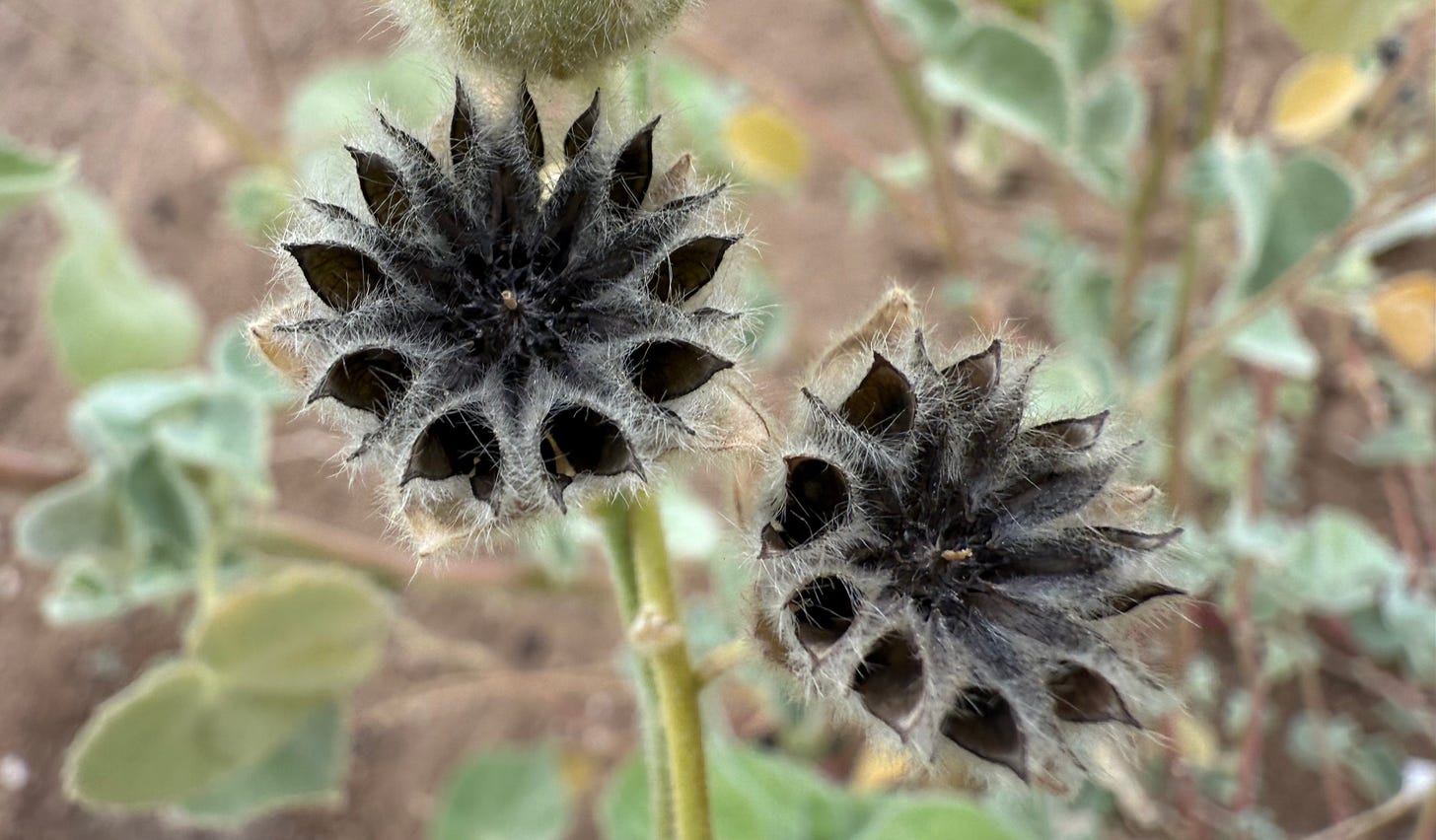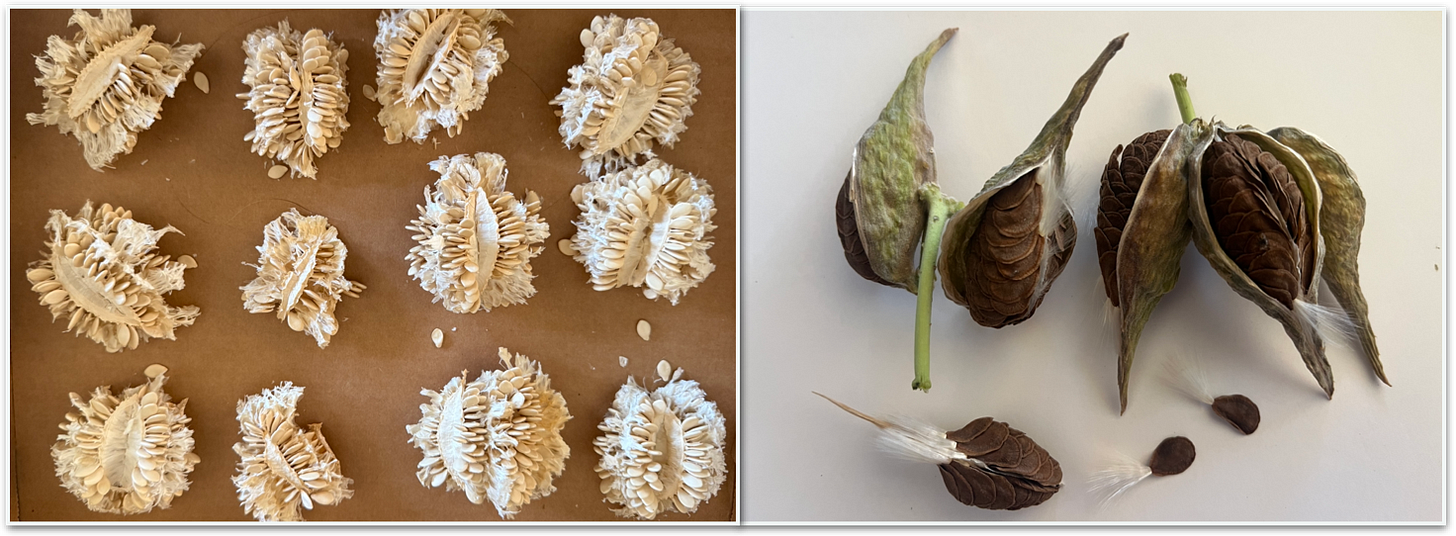Forget super blooms. We’re talking seeds, baby, the floral afterglow of autumn as the seasons cusp toward winter.
Wild hallucinations of flowers were then, this is now, and desiccated petals have fallen away to divulge the inner persona of native plants in the form of elegant, bizarre seed heads. We trend contemplative as the weather cools, and that allows us to see that blooms shed of their ornaments reveal that which is most purposeful in the life cycle of a plant.

Right about now the last remaining seeds are leaving their motherships. At their most basic they simply drop to the ground. But wing-shaped bracts or puffy attachments carry some seeds aloft in winds, and those with barbs or burrs hitch rides from passing mammals or shoes. Pods dry out and crack to release seed in a process called dehiscence,1 and certain festive-minded pods explode to fling their contents accompanied by a sound similar to a piñata popping open. Birds can transport seeds intercontinentally, and some insects are key-short range dispersers. Squirrels scamper with mouthfuls and dribble seeds on the way to their caches. Coyotes eat rodents with seed still in their bellies and spread their predator pies throughout territories as signposts: anecdotally, a local naturalist cites occurrences of palo verde seedlings growing from their scat. And the overriding objective of plants is to seek out new territories where offspring may be even better adapted. This mechanism offers hope as humans radically alter native habitats and is the guiding principle behind land management policies centered around climate refugia mitigation.2
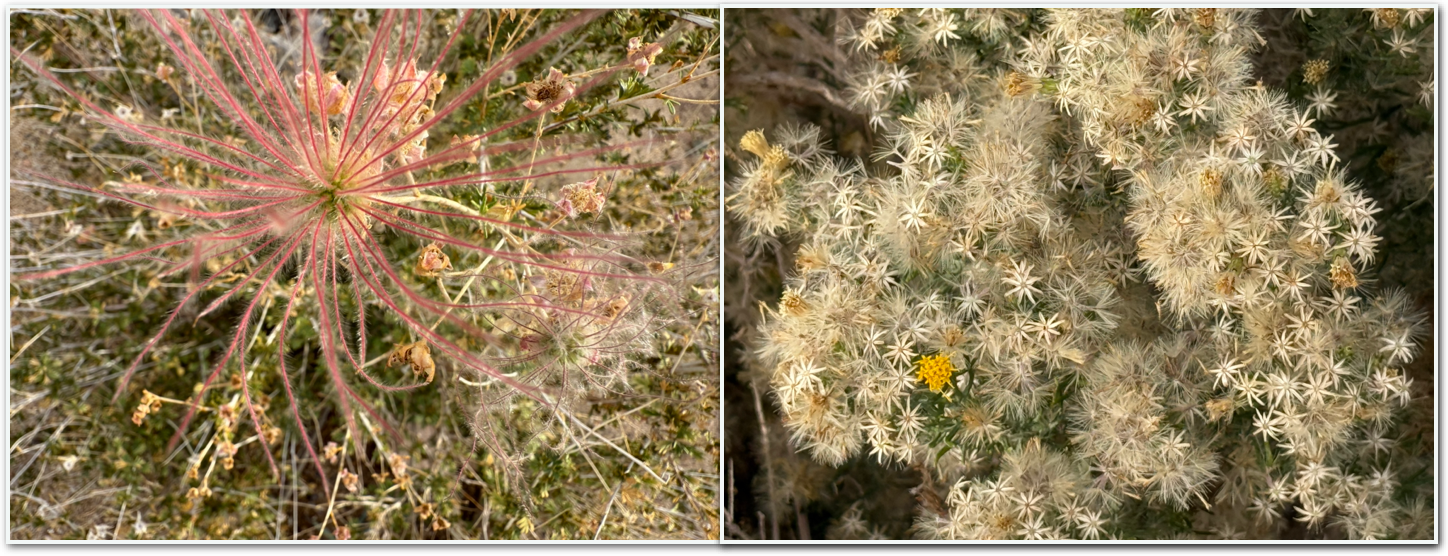
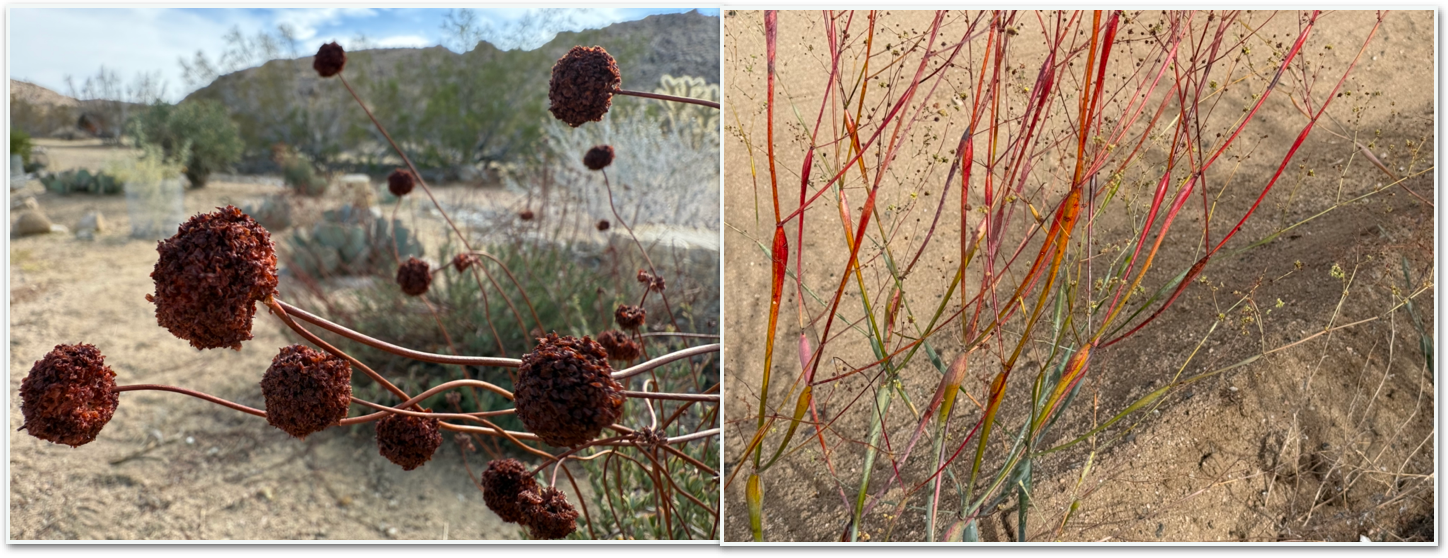
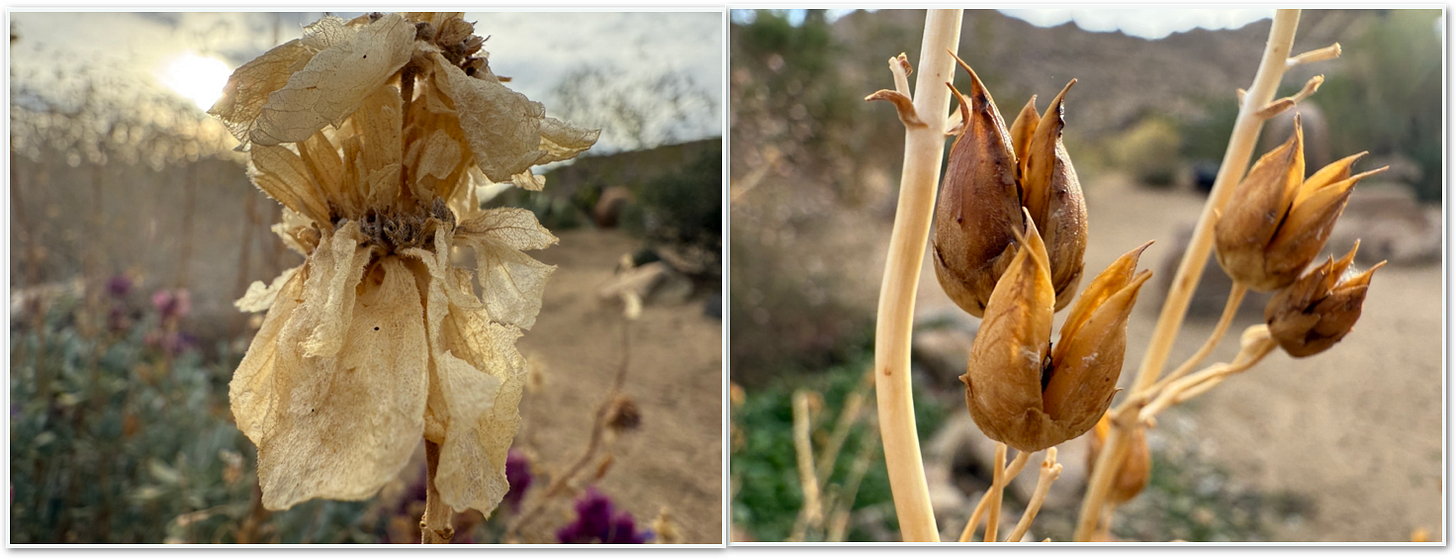
Once seeds travel throughout the landscape they become part of an in-ground seed bank. There they sit disguised as grains of desert soil, remaining in suspended animation inside their casements for months, years, or decades waiting for just-so triggers. Even when conditions align and a seedling is born, a percentage of that same species’ seed will exercise delayed germination,3 holding back for another time to ensure that sudden adverse weather or a roving herbivore won’t wipe out their entire generation.
The tiniest seeds need UV light to emerge, and once a brave little root radicle4 pokes out, their reserves can’t last the extra hours needed to push up through the soil before growing leaves to start processing food. Hence they remain hidden in plain sight on the surface of the ground, and almost all of our annual wildflowers fit into this group. Their viability is diminished by ground disturbance, blowers, and smothering blankets of invasive plants, many of which are unwittingly introduced through birdseed mixes and indifferent retail nurseries. Feathery exotic grasses, sexy though they may be, are among the worst garden escapees and also have harmful consequences for tortoises that mistake them for forage.5 Invasives are especially formidable because much of their seed can after-ripen,6 or continue to mature, even after being hula-hoed under or ripped out and left for dead.

How does a latent plant embryo decide it’s showtime? Through phytohormones called gibberellins.7 Let’s not go there other than to say that they kick off cellular shenanigans that break dormancy, largely based on water, light, upward movement in temperatures, and a host of super variable factors like whatever befell the seed after it departed the plant.
Cold weather rainfall is important for spring germination since Mojave plants evolved with winter rains, unlike the other Southwestern deserts with their summer precipitation patterns. Many seeds need an adequate period of chill called cold stratification8 to wake up as weather warms. Others require scarification,9 such as the abrasion of its coating by windblown sand, mandibles, or buck-toothed nibblers. Impervious seed casings sometimes need the help of an animal’s digestive tract, then there are the fire followers10 that need smoke or flames to stir.
And get this, it’s crazy: some have an oil filled blob—elaiosome if you must know11—that is manna for ant larvae. It entices colony workers to schlep seeds hither and yon, and germination is enhanced by ants abrading seed coatings as they extract the oil. Although diaspores (seed with elaiosome) are rare in the Mojave, ants harvest seed nonetheless and clean them, oft times imparting antimicrobial benefits of ant chemistry tiio12 Finally, the seeds are discarded at the mound entrance where soil is well aerated from tunneling, plus nutrient rich from insect carcasses or other organic refuse tossed out during nest cleaning. Time to rethink those ants in your plants as grub-lovin’ gardeners.
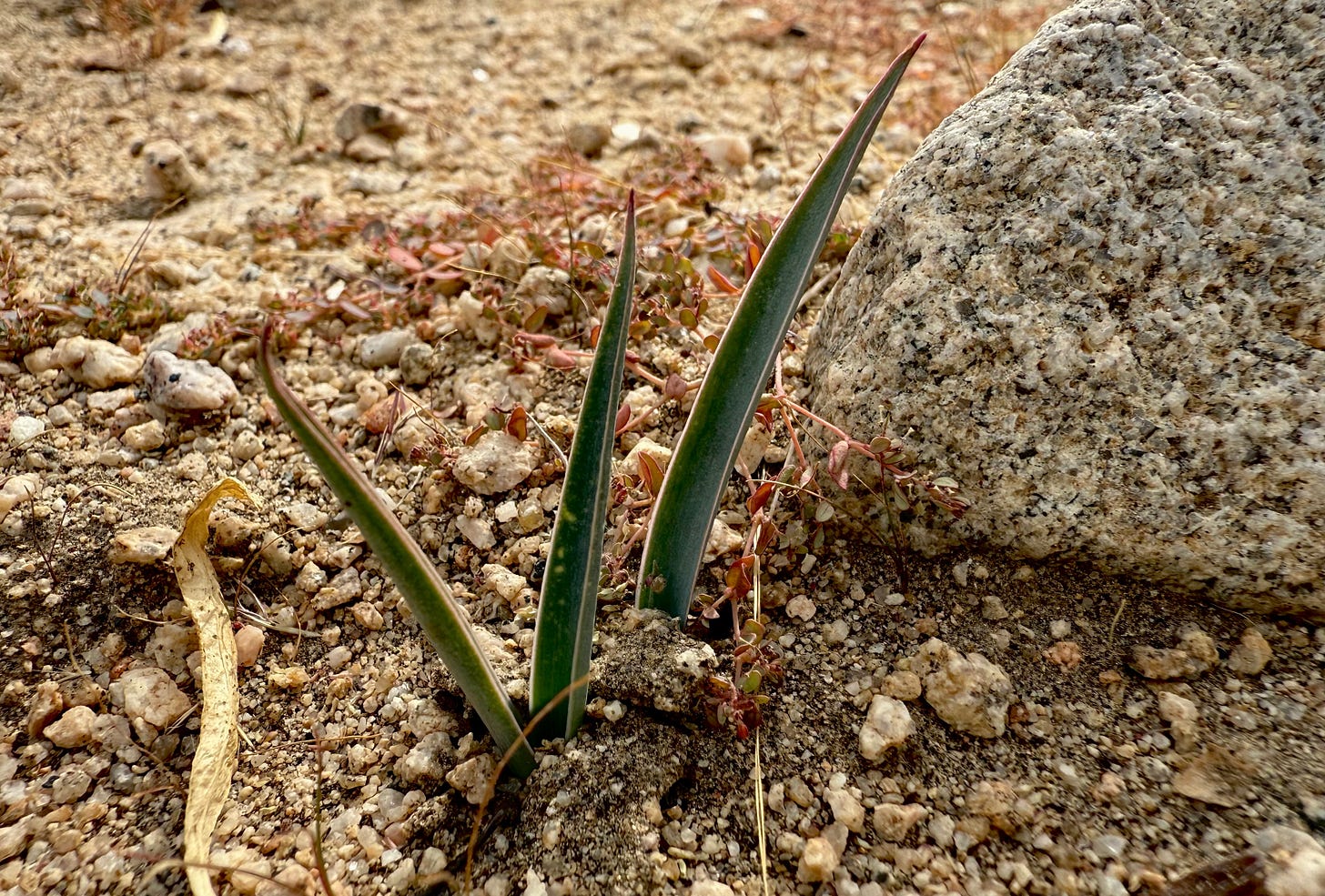
What the heck are seeds, anyway? Miniature dots and dashes that contain the enormity of nature. Her intricate web first seems like an impenetrable monolith, but insight comes easily by creating patches of ecosystems on our parcels, patios, or windowsills—sowing seed, using native plants that reseed, or just being mindful of the seed bank gifted to us. Rewilding has big impacts even when done small scale and is a powerful antidote for despair in a world where very soon your vote might not count. Rather, turning away from the noise is a choice opposite of putting on blinders: it’s a reminder that we are still vastly outweighed by the green biomass of the earth. Immersing oneself in the moving confluence of seasons and botany underscores the rhythms of our own species and weights us firmly on the ground, buoyed by the life underfoot.
Dehiscence, a process by which the parts of a plant containing mature seed dry and split open to empty their contents. The seed can escape in a number of ways.
Explosive dehiscence forcefully propels seed away from the plant and is described as ballistic dispersal. This is audible in some plants but not all.
Climate refugia mitigations commonly refer to management policies that either translocate species to, or set aside suitable habitat for species whose population numbers are struggling to adapt to warming temperatures. Examples in our area: higher elevation protected areas offer hope for Joshua trees and bighorn sheep.
Delayed germination is a broad term and can refer to seeds remaining dormant until adverse conditions lift. It is also used to describe another survival strategy, which holds back the germination of a percentage of seed even when conditions are favorable. The latter contributes both to the seed bank, and to genetic diversity by mixing the parentage of a plant “crop” in any given year.
The root radicle is the first part of the seed embryo to emerge and eventually develops into the root system. The radicle finds soil and grows downward to anchor the seedling as leaves begin to form.
Tortoises foraging on non-native grasses can experience nutritional deficits, foreign seeds impacting throats, noses and mouths, and a decreased ability to retain water reserves.
Other common invasives whose green seeds can mature after harvest include Russian thistle, brome grass, Sahara mustard, and Mediterranean stork’s-bill.
Phytohormones are a large group of plant hormones. Within that group, gibberellins are critical for seed germination.
Cold stratification can occur naturally with seasons or be simulated for purposes of cultivation by placing seeds in a cold, moist environment.
Scarification refers to processes that weaken hard seed coats, naturally or artificially, to promote the emergence of seedlings and most commonly involves nicking, scratching, or soaking.
Most Mojave plants are poorly adapted to fire but our fire followers include desert mallow, Mojave prickly poppy, wild heliotrope, and Anderson’s boxthorn. Their growth is variously reliant on, or enhanced by, chemicals in smoke or charred plant material in soil.
Elaiosomes offer ants oily goodness in exchange for dispersal. Although elaiosomes are atypical in Mojave plants, the symbiosis between ants, seeds, and soil exists regardless.
Ants possess antimicrobial agents used for cleaning nests, treating injured colony mates, and resisting disease. Chemicals from these natural defense mechanisms can be transferred to seeds, making them less susceptible to pathogens.
Leave your thoughts in the comments below. Please note that we do not allow anonymous comments. Please be sure your first and last name is on your profile prior to commenting. Anonymous comments will be deleted.
Feel free to share this article!
Help us reach our 2025 goal of $10,000 in subscriptions! Upgrade to a paid subscription for just $5 per month or $50 per year.
Would you care to donate more than $100? Our Paypal account is up and running!


